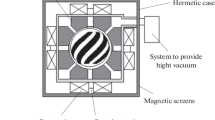Abstract
Classical torques acting on the GP-B gyroscopes decrease the accuracy in the measurement of the relativistic drift rate. Based on measurements made during the year-long science data collection, tests done following the science data collection, and a theoretical analysis of potential torques, there are two dominant classical torques acting on the gyroscopes. The first torque, known as the misalignment torque, has a magnitude proportional to the misalignment between the gyroscope spin axis and the satellite roll axis and is aligned perpendicular to the plane containing these two vectors. The second torque, known as the resonance torque, mainly produces a permanent offset in the orientation of the gyroscope spin axis when a harmonic of the gyroscope polhode frequency is in the vicinity of the satellite roll frequency. These two torques have the same physical origin: an electrostatic interaction between the patch effect fields on the surfaces of the rotor and the housing. In the post-mission data analysis, the change in the gyroscope orientation due to both of these torques can be clearly separated from the relativistic drift rate.
Similar content being viewed by others
References
R.J. Adler, A.S. Silbergleit, General treatment of orbiting gyroscope precession. Int. J. Theor. Phys. 39(5), 1291–1316 (2000)
S. Buchman, J.P. Turneaure et al. (2009, to be published)
T.W. Darling, Electric fields on metal surfaces at low temperatures, in School of Physics (University of Melbourne, Parkville, 1989), p. 88
W. de Sitter, On Einstein’s theory of gravitation and its astronomical consequences. Mon. Not. R. Astron. Soc. 77, 155–184 (1916)
C.W.F. Everitt et al., Gravity Probe B data analysis – status and potential for improved acuracy of scientific results. Space Sci. Rev. (2009, this issue)
M. Heifetz et al., The Gravity Probe B data analysis filtering approach. Space Sci. Rev. (2009)
J. Lense, H. Thirring, On the influence of the proper rotations of central bodies on the motions of planets and moons according to Einstein’s theory of gravitation. Zeitschr. Phys. 19, 156 (1918). English Translation: B. Mashhoon, F.W. Hehl et al., On the gravitational effects of rotating masses: the lense-thirring papers. Gen. Relativ. Gravitat. 16, 711–750 (1984)
B. Muhlfelder et al., GP-B systematic error. Space Sci. Rev. (2009, this issue)
R. Reasenberg, Filtering with perfectly correlated measurement noise. AIAA J. 10(7), 942–943 (1972)
M.E. Rose, Elementary Theory of Angular Momentum (Dover, New York, 1995)
A.S. Silbergleit, M.I. Heifetz, A.S. Krechetov, Model of starlight deflection and parallax for the GP-B data reduction. Gravity Probe B Document S0393, Stanford University, Stanford, CA, 2001
A.S. Silbergleit et al., Polhode motion, trapped flux, and the GP-B science data analysis. Space Sci. Rev. (2009, this issue)
C.C. Speake, Forces and force gradients due to patch fields and contact-potential differences. Class. Quantum Gravity 13, A291–A297 (1996)
Author information
Authors and Affiliations
Corresponding author
Rights and permissions
About this article
Cite this article
Keiser, G.M., Kolodziejczak, J. & Silbergleit, A.S. Misalignment and Resonance Torques and Their Treatment in the GP-B Data Analysis. Space Sci Rev 148, 383–395 (2009). https://doi.org/10.1007/s11214-009-9516-7
Received:
Accepted:
Published:
Issue Date:
DOI: https://doi.org/10.1007/s11214-009-9516-7




